
Living Luxe / Fall 2020
By Kelly Merritt
A Nation of Treasures
America’s glorious national parks evoke a sense of patriotism and pride
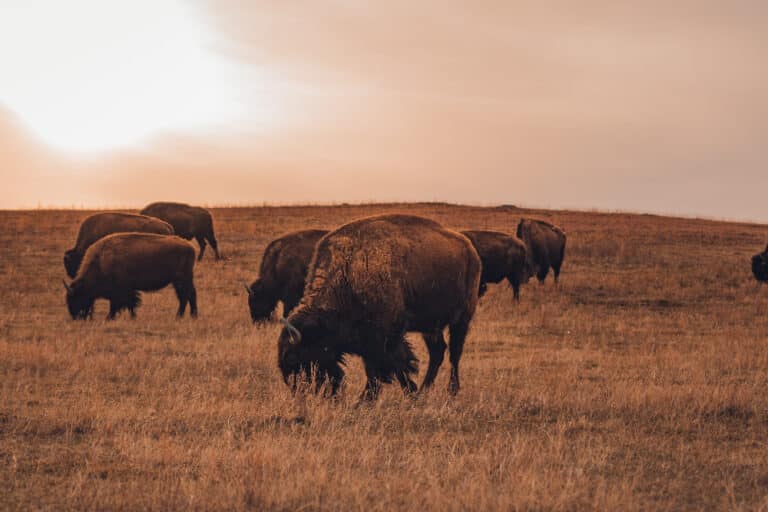
For Golden Crescent residents and throughout these United States, the past few months have been a circus of confinement and confusion. As the COVID crisis ravaged lives and the world economy, to step outside and take a breath is like emerging from a collective swamp to the first light of the surface. As the country awakens, albeit slowly and cautiously from its reluctant slumber, homebound Floridians long to resume the passion of discovery.
The remedy is the open road, where fresh air is free of charge, and the soul gets a recess from the daily grind. Nothing bookmarks a great America like national parks. They include monuments, shorelines, trails, battlefields and other historic sites (even the White House is included as part of the parks system). But it’s the grand expanse of natural wonders that calls us to its boundaries, choosing from among 419 national park areas and their 85 million acres.
These sacred lands are therapeutic reminders that they are protected for a reason. They ask for nothing but time. In return, they provide respite to reflect and revere, to heal and inspire. Authors have written hundreds of books about these hallowed grounds and the impact they have on the humans who enter them.
The mental health benefits of wandering through a national park, especially in these times, cannot be overstated. Dwarfed by towering redwoods. Lulled by the sound of a rushing river. Crushed by the weight of silence in a mammoth canyon. The vastness of nature puts man in his place and is a comforting force.
The godfather of American conservation and the 26th president, Theodore Roosevelt, recognized this phenomenon in the late 1880s. Wracked with grief, Roosevelt retreated to the Dakota Plains to mourn the passing of both his wife and mother. His own longing forged an unshakeable bond with the land, leading the statesman to set aside 200 million acres throughout America for wildlife refuges, reserves and national forests. For perspective, today there are more than 20,000 staff and nearly 300,000 volunteers within the National Park Service, which was created in 1916 after Roosevelt left office.
More than a century later, people still visit national parks to get what they lack: a sense of meaning and purpose in a chaotic world. And so, these larger-than-life gems remain a source of patriotism and tremendous pride in a country like no other.
Each park is magical in its own way. Here are a few to begin exploring, along with why they have earned such reverence.
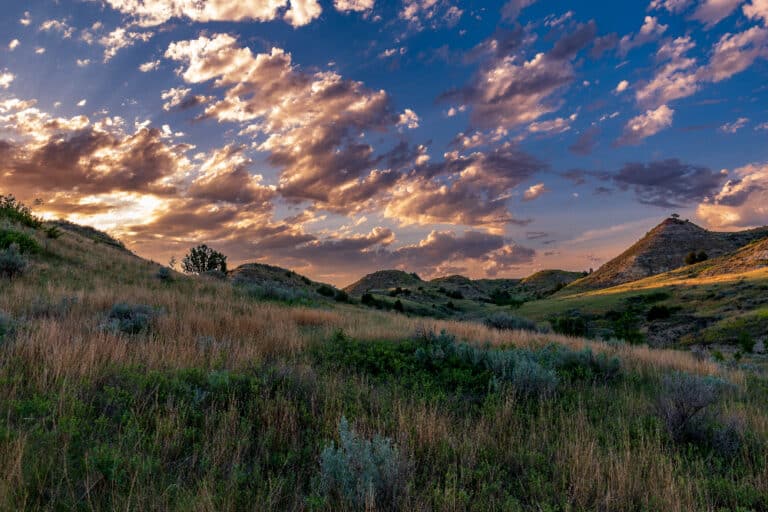
Gems Among Giants
Let them, and these parks will stir the spirit and imprint on the soul
North Dakota’s Theodore Roosevelt National Park continues the president’s vision of a wild and historic place. It is the remoteness of the vast, dry terrain known as the badlands that draws so many to its boundaries. Stretching across 70,446 acres, this wilderness paradise is divided into three geographically separated areas all linked by the Little Missouri River.
One such section is the undeveloped Elkhorn Ranch Unit, a boon for historic architecture buffs. This part of the park preserves the site of Chimney Butte Ranch, including the Maltese Cross Cabin, which is where Roosevelt retreated prior to his presidency. Built from ponderosa pine logs, the stateman’s humble former home features a replica of his writing desk. It’s easy to imagine this giant among men at work on one of his books while overlooking the Great Plains wildlife that so enthralled him during his life.
The second and third sections are known as the North and South Units of the park. They, too, feature jaw-dropping scenic drives and plenty of chances to view wildlife. Hiking enthusiasts find favor along dozens of trails, and overnight passes allow for more time to explore the backcountry.
“Look, don’t touch” is the mantra here. Conservation for wildlife was a passion for Teddy Roosevelt, and today his beloved bison, deer, elk and feral horses can be spotted throughout the park, as well as pronghorns of the greater Little Missouri National Grassland. Baying coyotes echo the evenings here, their howls enchanting and ancient. Beavers and porcupines dot the land while this vast terrain is also an outstanding place for birdwatching, including golden eagles at dawn and dusk.
Home Base: Unless you’re camping in the park and are well prepared, lodging and resources are scarce in this region. There are two towns adjacent to the North and South Units: Watford City is about 15 miles from the North Unit, while the South Unit’s closest town is Medora. Further away, Dickinson can be found about 35 miles east of the park.
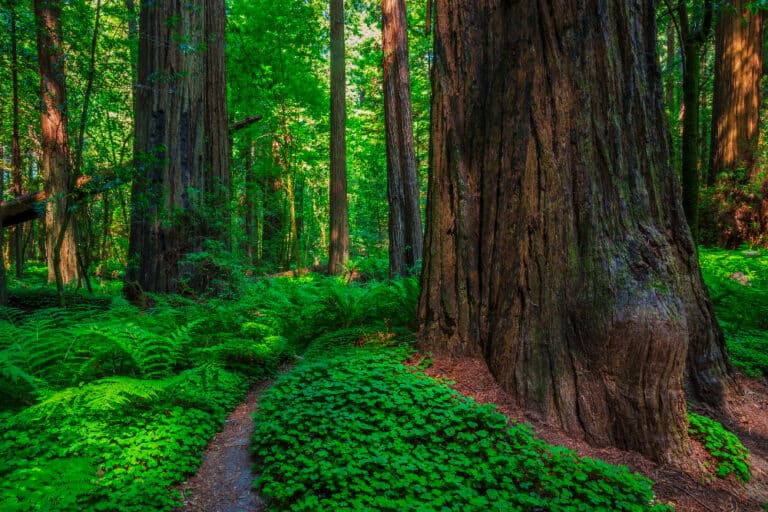
To stand among the redwoods is to realize the smallness of one’s humanity. The sky-high trees are just as impressive at their base, which can stretch dozens of feet around. It’s hard to imagine these coastal forests in Redwood National Park lost to time, but in the late 1970s the threat was very real. Logging activities nearby could have decimated its boundaries, but Congress protected the remaining watershed along Redwood Creek from being adversely affected.
It can be difficult to comprehend the breakdown of the Redwood National and State Parks (RNSP) — this joint partnership between California and the U.S. government dates back to the 1920s when concerned citizens began buying land to conserve redwood groves. Out of that effort sprung three state parks plus old-growth redwood forests that the federal government purchased from timber companies to preserve into a national space. The resulting acreage is split between the federally owned Redwood National Park and California’s Jedediah Smith, Del Norte Coast, and Prairie Creek Redwoods State Parks, all under the RNSP umbrella. Just 15 years ago, redwoods conservation expanded with the annexing of Mill Creek watershed, adding another 25,000 acres.
The largest of the individual Redwood State Parks, Humboldt Redwoods State Park, boasts the legendary Avenue of the Giants. This 31-mile section of historic U.S. Highway 101 is flanked by charming small towns and jaw-dropping views of soaring redwoods. Within the national park, among the most difficult hikes is the Tall Trees Trail traversing 800 feet down to the alluvial floodplain of Redwood Creek where hikers can view trees towering 350 feet.
Much easier on the body and with foliage every bit as stunning, the Prairie Creek Foothill Trail Loop is a flat 2.5-mile trail with a soothing ambiance thanks to the nearby babbling creek. Here, Prairie Creek Redwoods State Park houses some of the tallest redwoods in the world such as the Big Tree, which is well over a thousand years old and can be found along the Newton B. Drury Scenic Parkway near the Prairie Creek Visitor Center.
Car-bound visitors should take Howland Hill Road, an unpaved journey through Jedediah Smith Redwoods State Park that puts motorists so close, passing cars just narrowly miss the bark on these awe-inspiring trees. The closest access to this drive is from Crescent City via U.S. 199 near Hiouchi, California.
It’s not a myth that many of these trees are so wide visitors can literally drive their cars through their trunks. But parkgoers who plan a visit just to see the drive-through trees should adjust those expectations. These coastal redwoods are not within the actual park system and are only accessible through fee-based private businesses. One is a short drive from the center of the park in Klamath, while the others are located a bit further away towards the southern part of the state. They include Klamath’s Tour-Through Tree, Myers Flat’s Shrine Drive-Thru Tree, and Leggett’s Chandelier Tree. You’re a few decades too late if the plan is to see the famed Wawona Tree, which was actually a giant sequoia in Yosemite National Park which fell under a heavy load of snow in the late 1960s, leading to its new moniker, the Fallen Tunnel Tree.
A staggering 96 percent of the old-growth coastal redwoods have been logged, according to National Parks statistics. What remains is a once-in-a-lifetime vision of what might have been, as it is vital that these redwoods remain standing — and continue to be protected long after we have come and gone.
Home Base: Just south of the Oregon border, California’s hundreds of thousands of acres of redwoods parks have many access points. Humboldt County is a good place to start for its proximity to the Avenue of the Giants, lodging and scrumptious food scene. Unlike many national parks in remote locales, Northern California is a mecca of stunning chef-owned restaurants and picnic baskets brimming with gourmet goodies. California cheeses, steakhouses and fresh catches of Humboldt seafood are the hallmarks of this region. Consider spending the night at one of the area’s shoreline bed-and-breakfast inns — after all, a trip to see the redwoods must include California’s timeless coast. The two miles of secluded beach access at the Lost Whale Inn in the town of Trinidad should do the trick.
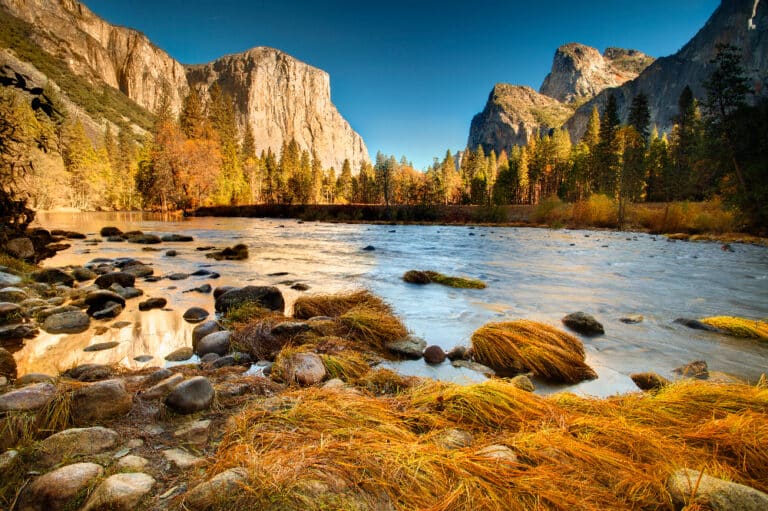
The Big Ones
Step right up to the edge of wonder as the iconic Yosemite and Grand Canyon check all the national park bucket lists
In the valley of a California dream, Yosemite’s waterfalls come crashing down into one of America’s most diverse and dramatic landscapes. While the cliffs and rock formations draw parkgoers by the millions, the rapids of Yosemite bring heartbeats into focus. These aren’t just any waterfalls. They are multi-cascade, grandiose, powerhouse falls that dare climbers to attempt steep trails, awarding the bravest with ridiculous views along the way.
One of the most frequently asked questions of park officials is, “How do we get to Horsetail Fall?” Best viewed in the winter and early spring, the seasonal Horsetail Fall on the El Capitan’s east side is most beloved by Yosemite patrons in mid-to-late February. During sunset, the waterfall reflects the last of the day’s sunlight, setting it afire with a gorgeous orange glow.
At 2,000 feet, Sentinel Falls on the southern side of Yosemite Valley has multiple cascades. Make a stop at Leidig Meadow or hike the Upper Yosemite Fall Trail for access, keeping in mind that peak flow occurs around May for Sentinel, as well as several other Yosemite waterfalls.
A popular horseback riding destination, Chilnualna Falls above the Wawona contains five cascades pouring over giant granite formations. Expect to find the best views overlooking Wawona here.
One of the tallest waterfalls in the world, Yosemite Falls is a cascading veil of three waterfalls, the upper fall towering at 1,430 feet, a middle cascade of nearly 700 feet, and the lowest fall at just 320 feet. It’s an easy stroll on a quick one-mile loop trail that leads to the base for prime viewing.
For the faint of heart or body, many parts of Yosemite should be off limits. Even the notoriously politically correct national parks website doesn’t mince words when referring to some of the more strenuous Yosemite hikes, saying, “The 14- to 16-mile round-trip hike to Half Dome is not for you if you’re out of shape or unprepared.” Another famed natural attraction of the park is the aforementioned El Capitan, rising 3,000 feet from the earth and is most popular among experienced rock climbers.
Home Base: It’s a challenge to pin down a single place from which to begin a Yosemite adventure. After all, the sprawling park encompasses 1,200 square miles. The best way to plan a visit is to check road and park conditions in advance and not trust GPS — as the website claims, there is no single address for a park this size. A historic lodging area rests amongst the three giant sequoia groves in Yosemite National Park, which include the Mariposa Grove, the Tuolumne Grove and the Merced Grove. The Wawona Hotel, formerly known as the Big Trees Lodge, is a California mountain original. About a half hour from Yosemite Valley in the Mariposa Grove, this Victorian-era beauty is a National Historic Landmark that dates back to 1856. Due to necessary repairs, the hotel isn’t expected to reopen until Spring 2021. And at the east end of the valley, the Ahwahnee Hotel distinguishes itself as one of the true crown jewels of national park lodges, known for its stunning stone architecture complementing the park’s natural habitat. There’s no more romantic evening spent than imbibing in its famed Ahwahnee Dining Room boasting 34’-high beamed ceilings with massive windows showcasing many of Yosemite’s greatest sites.
Regardless of where visitors stay, reservations are required to enter Yosemite, including for parkgoers seeking accommodations, camping or backpacking.
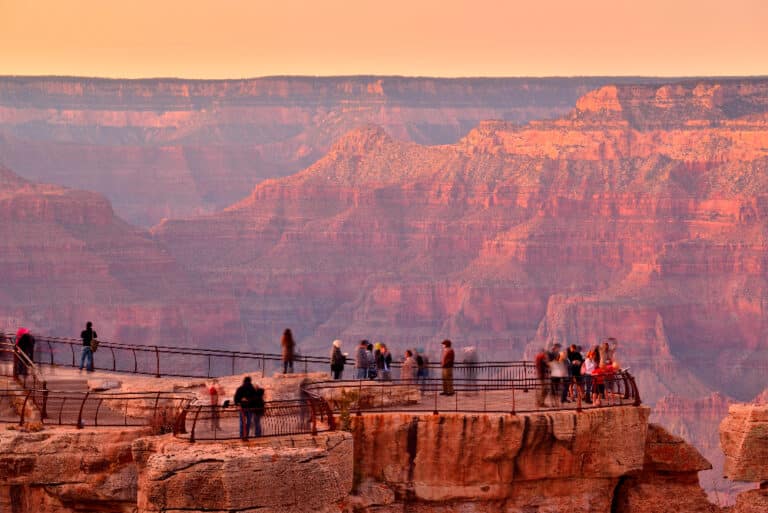
The sun rises on Grand Canyon National Park like an orchestra. Early rays glisten on the canyon walls, casting nature’s light show upon colorful bands of solid rock. Listen closely, for the winds whisper remembrances of the waters that formed these passages. One can only imagine the power of the currents that forged this ancient landscape.
The mighty Colorado River and adjacent uplands make up Grand Canyon National Park, within which the canyon itself is a mile deep and as much as 18 miles wide. The secrets of the rock spring forth in vibrant hues to reveal its geologic history dating back millions of years.
Hundreds of people are rescued from the Grand Canyon every year. A hike from the river to the rim in one day may seem tempting, but it’s impossible. Indeed, the warning is in red text in the hiking section of the National Park Service website and punctuated with an exclamation point: “There are no easy trails into or out of the Grand Canyon!” But that doesn’t mean hikers can’t enjoy this grand destination on foot. A day hike is the best bet unless you’re planning to camp overnight.
Various hiking trails along the South and North Rims open into the inner canyon — just make sure to relentlessly check for up-to-the-minute backcountry updates and closures before setting out. South Rim trails range from one accessible trail to “very steep,” with the easiest being the Rim Trail and the hardest being the Grandview Trail. Hiking up this rocky 1893 mining route might seem like the most challenging part, but just wait until you try to get back down. The return to the base is just as strenuous, as the severity of the drop intensifies strain on joints and muscles.
On the North Rim, the four-mile Point Imperial Trail takes about two hours to hike, passing through the region burned by the 2000 Outlet Fire and coming to an end at the north park boundary with connections to the Nankoweap Trail and U.S. Forest Service roads. For a combination of canyon scenery and forest life within the park, opt for the six-hour round-trip trek along the Widforss Trail.
Home Base: If you can get it, a stay in the Buckey O’Neill cabin at Bright Angel Lodge (circa 1935, designed by Southwest architect Mary E.J. Colter) is non-negotiable. In the 1890s, William “Buckey” O’Neill, a member of Teddy Roosevelt’s Rough Riders, built this cabin on the South Rim of the Grand Canyon. Colter was inspired to incorporate the abandoned cabin into the Bright Angel Lodge as a one-of-a-kind guest accommodation. Known for its canyon views from the very front door, the cozy suite is so sought after, it must be reserved well in advance. The Bright Angel Lodge itself is a Registered National Historic Landmark and deserving of praise for its rustic stone beauty, made famous post-train travel in 1901 and located at the top of the Bright Angel Trail Head.
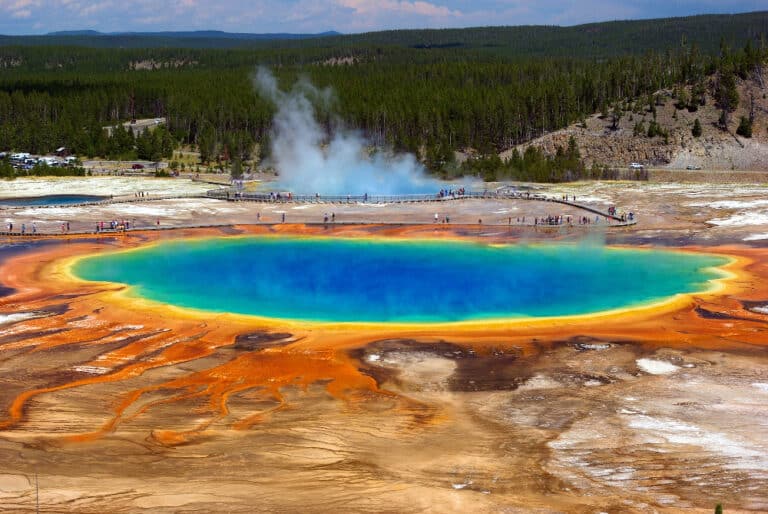
In the footsteps of our forefathers, there was no greater wilderness to tame than what would become Yellowstone National Park. Once upon a time, the terrain was unforgiving and impassable to early explorers. As foreign to them as the moon was to us before space exploration, this rugged Wyoming backcountry, in parts reaching into Idaho and Montana, lured the bravest of them, often in what would be their last adventure. Yellowstone remains tinged with the spirit of what it means to persevere and overcome. It still humbles humans who try to harness that which cannot be kept.
Recognizing Yellowstone as a priceless treasure early on, President Ulysses S. Grant signed the Yellowstone National Park Act in 1872, which protected its two million acres from settlement, sale or occupancy, dedicating what became our country’s very first official national park to “the benefit and enjoyment of the people.” Among the protections listed included the preservation of timber, mineral deposits and natural curiosities within Yellowstone — a move which helped set the stage for protecting future lands.
Certainly, wildlife danger is very real here — just catch a viral video of selfie-hunting tourists getting clawed by bears. But ironically, the most dangerous attractions in the park are also among the most alluring to both new and seasoned visitors. They are Yellowstone’s prolific geothermals, boiling hot springs which originate below the surface of the earth. The truly clueless pay with their lives — wandering aimlessly into geyser basins or other geothermal attractions, drowning or being burned by hot springs which can be highly acidic.
Old Faithful has a slightly less ominous name and has been the chief reason for visiting the park for millions of people for decades. At least 10,000 hydrothermal features can be found throughout Yellowstone, with about 500 of them being geysers, including Old Faithful and the Great Fountain Geyser. Visitors also love to watch the mudpots, their grumpy bubbles gurgling to the tune of the planet’s indigestion. Expect to also find an abundance of hot springs, travertine terraces (hot springs which rise through limestone) and volcanic fumaroles, which operate like vents, constantly releasing hot steam.
Home Base: The best place to lay weary heads after a day at the park is to pitch a tent under the stars in our 18th president’s namesake, Grant Village Campground. There are more than 400 camping spots to choose from and nearly 20 public restrooms. Luxury bonus: Campers have access to flush toilets and cold-running faucets, but there are pay showers at the camper services facility nearby.
National Parks are a respite for adventurers, those yearning to overcome spiritual obstacles or persevere beyond challenges. They are a magnet for visitors simply looking for inspiration among what’s left of the wilderness within these borders.
The best way to see as many of these national treasures as possible is via an America the Beautiful National Parks and Federal Recreational Lands Pass. This ultimate parks pass grants access to more than 2,000 federal recreation sites and covers entrance fees at national parks and national wildlife refuges, among other perks — though fewer than one-third typically charge entrance day-use fees. For a list of all the national parks in the system and up-to-date information on COVID-era openings, visit nps.gov and be sure to click on the specific area of interest to confirm hours and additional visitor information.
